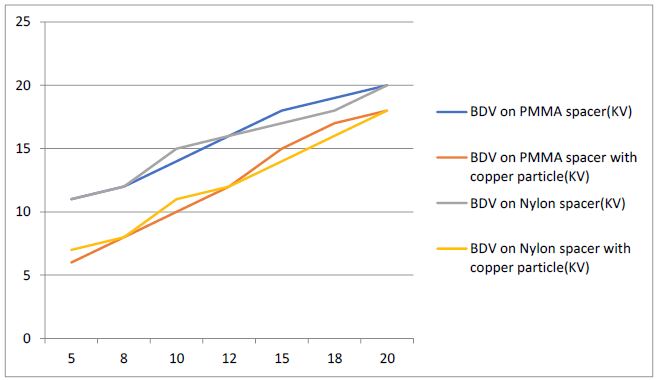Effect of Conducting Particle on Spacers in Air Insulated Systems
DOI:
https://doi.org/10.5281/zenodo.14538982Keywords:
breakdown voltage, gas insulated system, spacers, conducting particleAbstract
Gas Insulated System (GIS) has been known to be reliable for more than 40 years. One of the reasons is because the active components are installed inside sealed-enclosures that reduce the environmental stress. Gas Insulated systems require solid insulating materials to provide mechanical support for conductors. Hence the spacers used in GIS should be precisely designed to realize more or less uniform field distribution along their surfaces. GIS occupy an important position in the power system. Insulating spacers are important parts in GIS. GIS have been used for many years as a means to provide safe and reliable high volt-age electrical systems. Normally, the problems connected with the use of these systems are few, especially when lower voltage levels are considered. However, the presence of metallic contamination can seriously reduce the insulation performance of a GIS. The aim of this work is to investigate the effect of conducting particle on spacers in air insulated system. The spacers used for study are Poly Methyl Metha Acrylate (PMMA) and nylon.
Downloads
References
T. Hara, N. Sugiyama, & K. Kita. (1983). Improved surface flashover characteristics of SF, gas spacers contaminated by conducting particles. Proc. 4th Int. Symp. on HV Engineering, 34(01).
F. Endo, T. Yamagiwa, T. Ishikawa, & M Hosokawa. (1986). Particle-initiated breakdown and reliability improvement in SF6 gas insulations. IEEE Trans. Power Delivety, PWRD-I, 58-65.
M. Hara, H. Tabata, K. Hidaka, & H. Yakabe. (1987). Influence of conducting particles on insulation performance of conical spacer in SF, gas under dc voltage. Proc. 5th Int. Symp. on HV Engineering, 15(03).
M. Hara, K. Hidaka, K. Kanazawa, & T. Higuchi. (1988). A basic study on improvement method of withstand voltage of particle-contaminated spacer in N2 gas and N2/02 mixture. IEEE Trans. of Japan, 108-A, pp. 343-350.
M.M. Morcos, S.A. Ward, & H. Anis. (1999). Particle-initiated breakdown with spacer involvement in compressed gas and its mixtures. Conference on Electrical Insulation and Dielectric Phenomena.
B. Mazurek, J. D. Cross, & R. G. van Heeswijk. (1993). The effect of a metallic particle near a spacer on flashover phenomena in SF6. IEEE Transactions on Electrical Insulation, 28(2).
Han Wang, Jianyi Xue, Chen, Junbo Deng, Guanjun Zhang, & Shaoxin Meng. (2019). Effects of metal particle material on surface flashover performance of alumina-filled epoxy resin spacers in SF6/N2 mixtures under DC voltage. AIP Advances, 9, 085212. doi:10.1063/1.5110976.
Purnomoadi, A.P., Mor, A. Rodrigo, & Smit, J.J. (2020). Spacer flashover in Gas Insulated Switchgear (GIS) with humid SF6 under different electrical stresses. Electrical Power and Energy Systems, 116, 105559, 0142-0615/© 2019 The Authors. Published by Elsevier Ltd.
Elham Foruzan, Amir A.S. Akmal, Kaveh Niayesh, Jeremy Lin, & Desh Deepak Sharma. Comparative study on various dielectric barriers and their effect on breakdown voltage.
M.S. Naidu, & V. Kamaraju. (2013). High voltage engineering. (5th ed.). Tata McGraw-Hill.
R. Sarathi. Some factors affecting the breakdown strength of solid dielectrics. Indian Institute of Technology Madras, Department of Electrical Engineering Chennai, India.
Dr. K.L. Ratnakar, Dr. B. Rajesh Kamath, & Dr. J. Sunderarajan. Comparative study of DC and lightning impulse breakdown voltages of air gaps with and without spacers.
Phloymuk N, Pruksanubal A, & Tanthanuch N. DC breakdown voltage of solid dielectric barrier under non-uniform electric field.

Published
How to Cite
Issue
Section
ARK
License
Copyright (c) 2024 Jouhar C, B. Rajesh Kamath

This work is licensed under a Creative Commons Attribution 4.0 International License.
Research Articles in 'Applied Science and Engineering Journal for Advanced Research' are Open Access articles published under the Creative Commons CC BY License Creative Commons Attribution 4.0 International License http://creativecommons.org/licenses/by/4.0/. This license allows you to share – copy and redistribute the material in any medium or format. Adapt – remix, transform, and build upon the material for any purpose, even commercially.










